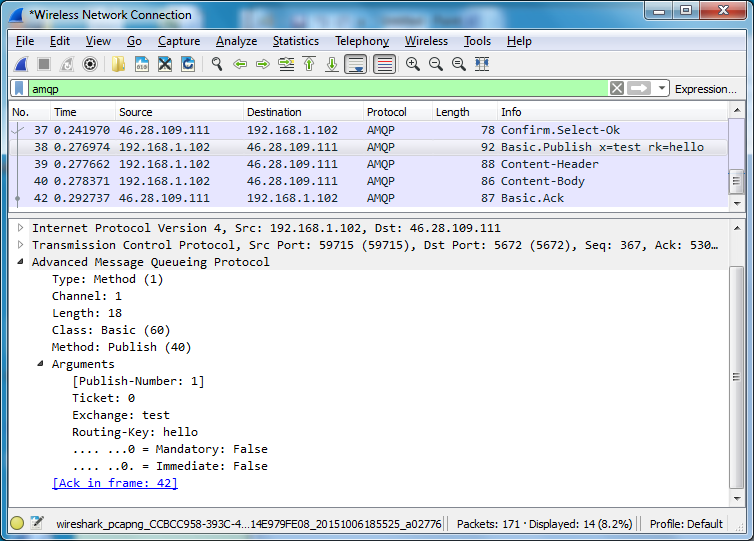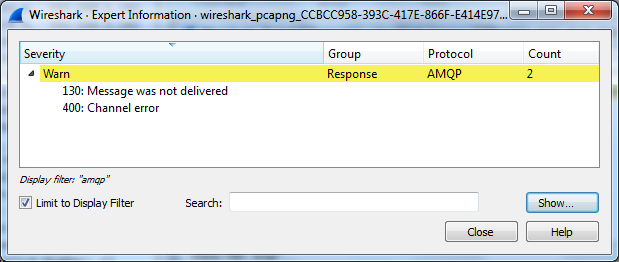Inspecting AMQP 0-9-1 and AMQP 1.0 Traffic using Wireshark
Overview
Wireshark is a graphical tool that can capture traffic and inspect it, or inspect a traffic capture taken on a different host.
Modern Wireshark versions contain support for AMQP 1.0 and AMQP 0-9-1 traffic inspection and analysis. It can dissect (parse, visualise, filter) AMQP 0-9-1 and AMQP 1.0 traffic, including AMQP 0-9-1 Errata and RabbitMQ Extensions.
Wireshark is based on the same foundation as tcpdump, a library called libpcap,
and can be used to inspect pcap traffic capture files taken in a server environment.
Together, tcpdump and Wireshark provide a lot of information explaining what clients (applications) and RabbitMQ nodes
send and receive. This information can and should be used to derive insights into system behavior that is difficult
to observe otherwise. These tools complement metrics, logs,
internal events, all to allow operators and developers troubleshoot a distributed system more efficiently.
Traffic captures are particularly useful for analyzing message flow, unroutable messages, publisher confirms and consumer acknowledgement use by applications.
Tracing AMQP 1.0 and AMQP 0-9-1
On startup, Wireshark will display a list of interface to start a traffic capture on. Modern versions will explicitly highlight the primary network interace on the host (as inferred from the Wi-Fi network interface) and the loopback (local) interface.
To begin tracing AMQP 1.0 or AMQP 0-9-1 traffic, start a capture on a relevant network interface, then filter for "amqp" in the "Apply a display filter" search box.
The Packet List view provides a summary of protocol frames and methods exchanged by a client and a RabbitMQ node.
The Info column indicates the Class and Method (e.g. Basic.Publish)
and then the most significant arguments. For example:
Connection.Open vhost={name}Connection.Close reply={reply-text}Channel.Close reply={reply-text}Exchange.Declare x={exchange-name}Exchange.Bind dx={dest-exchange} sx={source-exchange} bk={routing-key}Queue.Declare q={queue-name}Queue.Bind q={queue-name} x={exchange-name} bk={routing-key}Queue.Delete q={queue-name}Basic.Publish x={exchange-name} rk={routing-key}
Packet Details then indicate all the properties of the frame. It also includes dynamically calculated values enclosed in square brackets.
Below is an example of a Wireshark window with an active capture and the "amqp" display filter enabled.

Links Between Related Frames
Wireshark analyzes the AMQP 0-9-1 packet flow and displays additional information enclosed in square brackets:
- Arguments of basic.publish include a publish sequence number, which is the sequence number used by Publisher Confirms
- Each acknowledged basic.publish or
basic.deliverincludes a reference to the frame that contains the correspondingbasic.ackorbasic.nackframe that acknowledged it (if any). - Similarly, each basic.ack contains a reference (possibly multiple) to frame(s) that is being confirmed by this Ack
More Metrics
Wireshark automatically highlights AMQP 0-9-1 packets with:
- Connection errors (server-sent
connection.closeframes) and channel errors (server-sentchannel.closeframes) - Unroutable returned messages messages (
basic.returnframes)
You may display summary of significant frames in a dedicated dialog. Go to Analyze > Expert Information and possibly apply the display filter:

Inspecting Traffic on TLS-enabled Connections
Wireshark enables you to inspect the AMQPS traffic, however you can decrypt only the traffic that have been encrypted using the RSA keys, excluding the RSA ephemeral and Diffie-Hellman Ephemeral (DHE/EDH) cipher suites. You should set cipher suites used by RabbitMQ and restrict the list to RSA only.
In addition, Wireshark must be provided with the private key used to encrypt the data. If a mutual peer verification is used, both client and server private keys must be added to Wireshark.
To do so, go to the Edit > Preferences dialog in the menu, select Protocols > SSL and
then use Edit the RSA keys to add private key file paths to the list.
The interface will contain a few values to fill:
- IP Address and Port identify the host that holds the private key, usually the server. A wildcard IP address of 0.0.0.0 and wildcard port of 0 or data can be used
- Protocol should be set to
amqp - The private key file should be in the PEM or PKCS12 format, optionally protected by a password